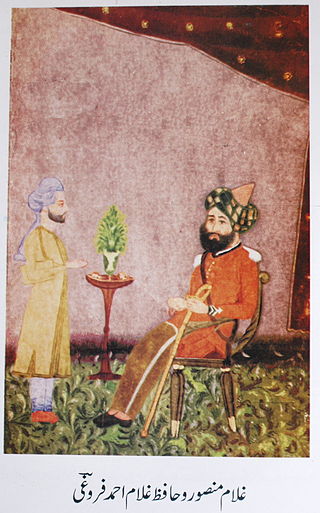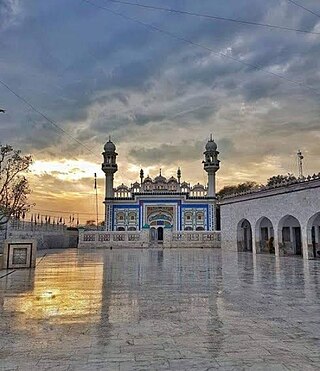
Sayyid is an honorific title of Hasanids and Husaynids Muslims, recognized as descendants of the Islamic prophet's companion, Ali through his sons, Hasan and Husayn.
Zaidpur is a town and a nagar panchayat in Barabanki district, Uttar Pradesh, India.

An Iranian architect is traditionally called a mi'mar.

Sayyid Dildar 'Ali, also known as Ghufran-Ma'ab Naseerabadi, was a Shia scholar of India, from the village of Nasirabad, Raibareli in Uttar Pradesh, India. His best-known work is "Imad-ul-Islâm", in Arabic, a refutation of the anti-Shia arguments used by the famous Fakhr al-Din al-Razi.

Sayyid Jalaluddin Surkh-Posh Bukhari (Persian: سید جلال الدین سرخ پوش بخاری, c. 595-690 AH, 1190 – 1295 CE was a saint from the Indian subcontinent. He belonged to the Jalali Sufi order and was descended from the 10th Imam, Ali al-Hadi.
Hallaur or Hallor village is located in Domariyaganj Tehsil of Siddharthnagar district in Uttar Pradesh, India. Domariyaganj is the nearest town to Hallaur village.

Hakim Syed Muhammad Karam Hussain was an Unani practitioner from Tijara, Alwar.
Qāḍī Sayyid Rāfiʿ Muḥammad Dasondhi was a scholar of repute from Sakras, District Gurgaon. He belonged to the family of Gardēzī Sadaat.

Ghulam Mansoor was Subedar-Major in 1867 at Bhopal State.

Tafazzul Hussain Khan was a key army personnel during the 1857 revolt. He was Risaldar of a mounted troop (Risala) during 1857 Indian revolt and was entitled, 'Captain' and 'Sardar Bahadur' by British India.
Dooru Shahabad is a town and the headquarters of the Dooru tehsil in the Anantnag district of the Indian union territory of Jammu and Kashmir. It is also known as a historical township in South Kashmir's Anantnag district. Doru Shahabad is considered as a place of intelligence, where great scholars like Mehmood Shah Gami, Rasul Mir Shahabadi & Waris Hafiz Itoo were born. These scholars contributed to the literature and culture of Kashmir. In present times, Shahabad has produced chief ministers such as Syed Mir Qasim, and other politicians, bureaucrats, and leading agricultural scientists.

The Ashurkhana Sayyid Jamshed Ali Khan, also known as the Lohe Ki Kamaan, is an ashurkhana in Hyderabad in Andhra Pradesh, India. It was built during the Qutb Shahi dynasty in 1060 hijri during the reign of Abdullah Qutb Shah.
The Ijtihadi family is sub-branch of the Naqvis#Naqvis of Darul Ijtihad Jais, Nasirabad and Parshadepur Raebareli. The family uses last name "Naqvi" to denote that they are descendants of the Islamic prophet Muhammad through the lineage of the Imam Ali al-Naqi.
Sayyed is one of the clerical and religious in Afghanistan and Pakistan.

Shah Jewna, also known as Pir Shah Jewna Mahboob Alam Naqvi Al-Bukhari was a 15th century saint and a Naqvi Sayyid. Born in Kannauj in 895 A.H., he was a direct descendant of Jalaluddin Surkh-Posh Bukhari, Jewna’s father Sayyed Sadruddin Shah Kabir Naqvi Al Bukhari was the chief advisor of King Sikandar Lodi.












